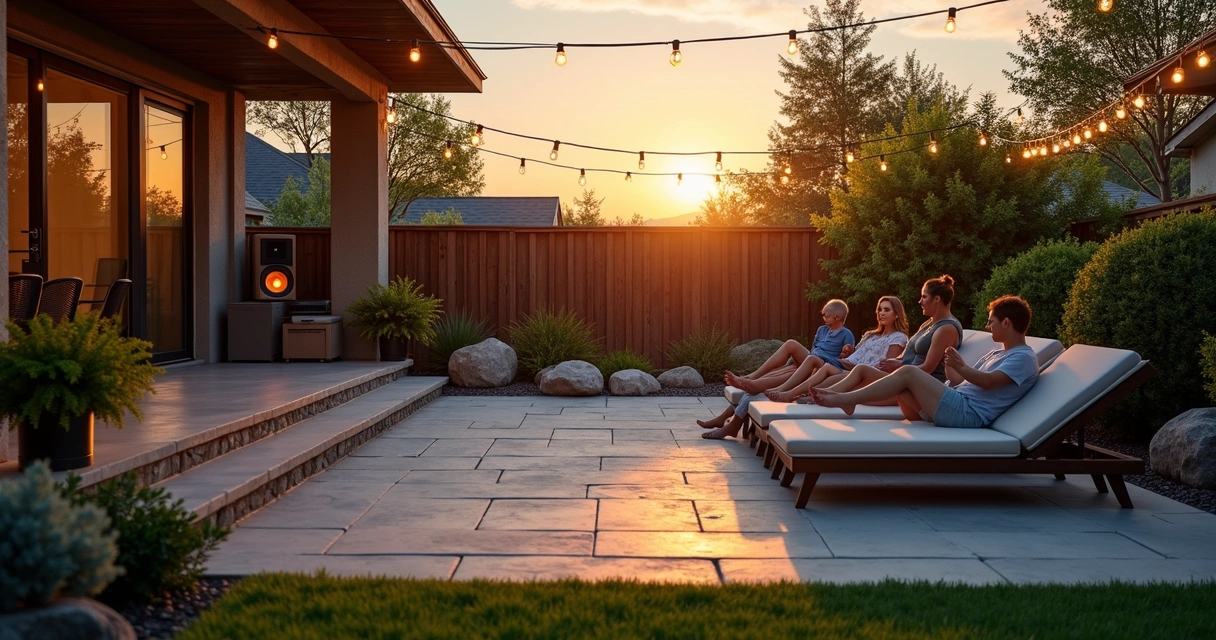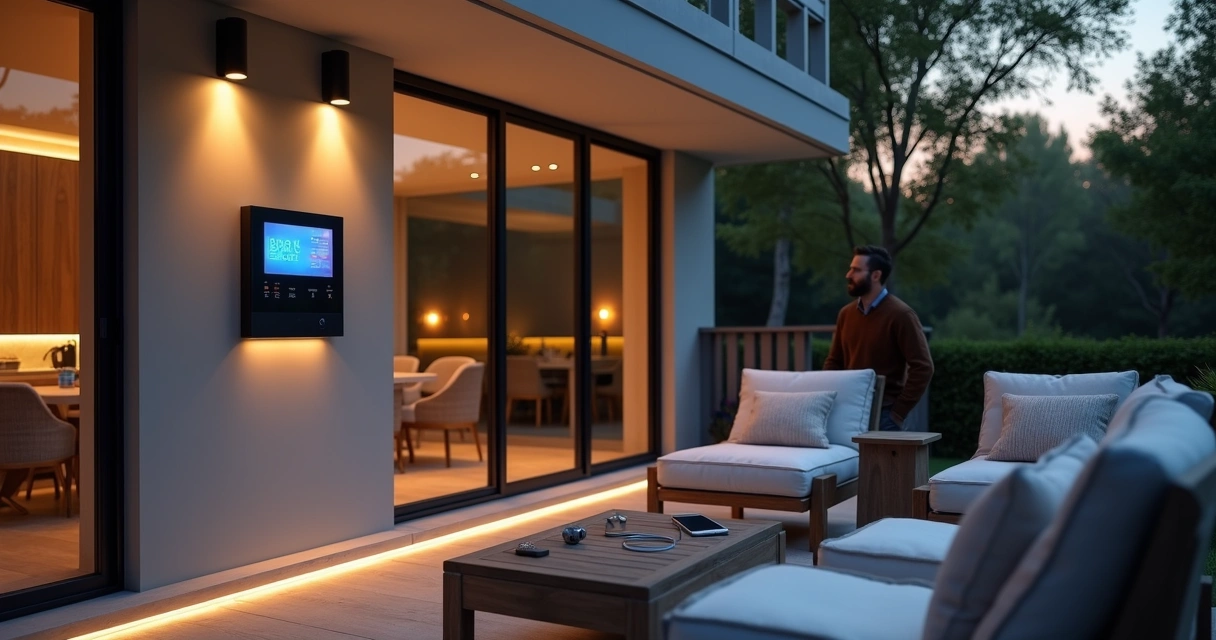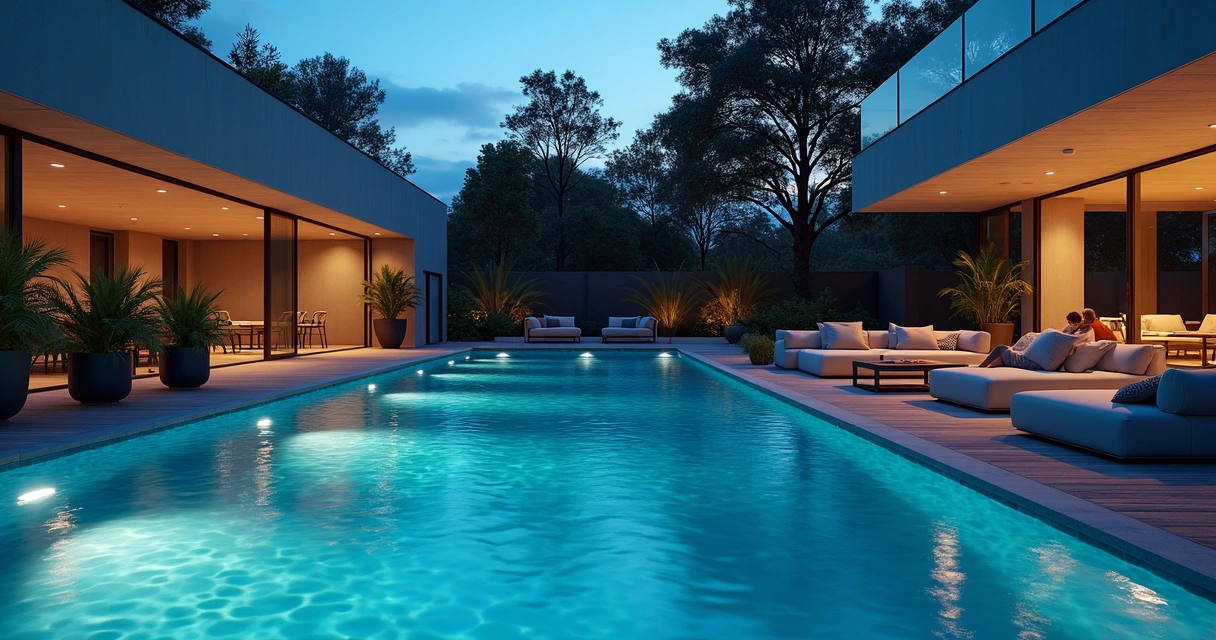Imagine stepping outside on a mild evening, the patio lights setting the mood, friends chatting, and gentle music floating in the background. Your backyard isn’t just a patch of grass; it becomes an extension of your living space. Maybe you’ve thought about adding music outdoors, but wondered how people really achieve that seamless, always-ready sound?
The world of outdoor audio is changing fast. Technology and design are working together more than ever, shifting from old bulky speakers to integrated solutions that blend into gardens, patios, and decks. As expectations grow for outdoor comfort, audio systems are right at the center—mixing lifestyle and tech.
Why outdoor sound matters more than ever
Our outdoor spaces aren’t just for gardening or grilling; increasingly, they’re for entertaining, unwinding, and even working. The right sound system sets the tone—whether you’re hosting a casual brunch, a birthday party by the pool, or a quiet evening with family. Music outdoors isn’t about volume; it’s about atmosphere and creating what feels like your own private resort.
According to recent market data, portable outdoor speakers accounted for over 67% of global sales in 2023. That suggests many people value convenience and mobility, but the rise in smart, fixed systems means more homeowners want comprehensive, built-in experiences too.
The new era of outdoor sound: beyond the boombox
Gone are the days of dragging a radio outside or opening windows just to share indoor music. Outdoor audio systems now blend technology, design, and durability. Modern solutions come in many forms—rock speakers hidden in landscaping, discreet in-ceiling patio speakers, or smart speakers on your deck.
But the dream isn’t just about loudness—it’s about music that fits seamlessly into moments, with as little fuss as possible.
 How outdoor audio systems are designed differently
How outdoor audio systems are designed differently
Indoor and outdoor spaces are as different as night and day. The sounds bounce off walls inside, but in the open air, music dissipates quickly. That’s why outdoor speakers need specialized design—weather resistance, broader sound coverage, and materials built to survive sun, wind, and rain.
- Weatherproof construction: Outdoor speakers have to withstand heat, cold, rain, and, sometimes, insects. According to Lucintel reports, manufacturers are prioritizing ruggedness and smart integration.
- Acoustic reach: With airflow and open space, outdoor sound needs more careful placement and extra power. It’s not just about blasting music louder; it’s about even sound for everyone—without bothering the neighbors.
- Smart integration: New systems connect with your Wi-Fi, voice assistants, and even lighting, so control is always at your fingertips.
Urban Oasis, for instance, has seen growing demand for audio solutions that work flawlessly with patios, decks, pergolas, outdoor shade structures, and custom landscaping—systems that remain almost invisible until you hear them.
The lifestyle upgrade: living with outdoor audio
What’s it really like to have high-quality sound outdoors? Take a summer barbecue—a playlist drifts through the garden, clear enough to energize, but never overbearing. Children play by the pool, timers sound, calls are answered hands-free. Behind the scenes, weatherproof speakers and smart controls ensure reliability—even when it suddenly rains. There’s no scramble to take gadgets inside. Just relaxation, maybe even a little pride.
Sound shapes the mood as much as the space itself.
These systems do more than supplement an experience; they can become the core. With well-placed backyard smart speakers, you can:
- Host movie nights on the patio with immersive surround audio.
- Guide workouts by the pool with energizing beats.
- Enjoy audiobooks while gardening, using your voice to cue chapters.
- Stream podcasts or news while you cook or grill.
Elements of a successful outdoor sound system
If you’re considering an outdoor audio project, it’s easy to get lost in choices—wireless or wired, portable or permanent, landscape or wall-mounted? Sometimes the only answer is, “It depends.”
Let’s walk through what tends to matter most, no matter the setup.
Weather resistance: materials that endure
According to industry insights, manufacturers are now pushing boundaries: waterproof coatings, UV-resistant plastics, stainless fasteners, and grilles that resist rust. Longevity matters—no one wants a speaker shorting out mid-celebration. Some modern models withstand everything from downpours to sudden freezes.
Strategic placement: mapping sound to your space
Coverage is key. Place too few speakers, and you’ll get hot and cold spots—loud near the wall, barely a whisper by the lawn. Overdo it, and the sound feels cluttered. That’s why a professional’s touch counts. The Automated Lifestyles blog stresses how pros survey each site, noting wind, direction, and potential echo, then plan for gentle music across the entire backyard.
- Landscape speakers: Hidden in planters, disguised as rocks, or staked in garden beds.
- Wall-mounted units: Tucked under eaves, directed toward gathering spaces.
- Buried subwoofers: Delivering bass you feel, not just hear, while staying invisible.
 Integration with smart devices: effortless control
Integration with smart devices: effortless control
Remote controls are becoming rare as app-based, voice, and even automated scheduling take over. Want to change the playlist from your hammock? You can. Need music to fade away when everyone goes inside? A routine can handle that. Some backyard smart speakers even integrate with outdoor lighting, fire pits, or irrigation, so everything feels connected.
Connection and power: wired, wireless, or hybrid?
Wireless speakers are surging in popularity (as shown in the Verified Market Reports). They’re flexible and easy to set up, but still have limitations—range, charging needs, and occasional dropouts. Wired systems may seem complex upfront, yet they offer consistency and never run out of battery at the wrong time.
Increasingly, homeowners look for hybrid setups: main wired speakers throughout the yard, complemented by portable speakers for flexibility.
Step-by-step: how an outdoor audio system comes together
The process is a journey more than a purchase. You’ll want to think beyond just cost or brand—how you actually use the space, how sound might travel, or what your lifestyle asks for.
1. envision your space
How do you use your backyard? Are you cooking, lounging, swimming, or doing all three? A small urban courtyard calls for a different approach than a sprawling lawn. Begin by imagining that “soundtrack” to your favorite outdoor moments.
If you need inspiration, checking portfolios from companies like Urban Oasis helps to visualize how ambient sound fits in with modern outdoor living environments.
2. site assessment and planning
A thorough assessment considers more than just measurements. Acoustics, wind direction, existing landscaping, and even materials used on patios matter. As explained by installation experts, professionals look for areas that amplify or deaden sound, and choose placements that minimize interference.
3. choosing speakers and tech
The latest research highlights consumer priorities: durability, clarity, battery life, and connectivity. If your pool and patio are in full sun, make sure your selection handles heat. If you’ll use voice assistants, favor smart-enabled speakers.
- Battery-powered options: Perfect for flexibility and casual events.
- Wired speakers: More reliable for consistent entertainment zones.
- Hybrid systems: Marry flexibility with dependability.
Consider also how your sound system might grow. You may start with one zone, but wish to add more as you expand your deck or introduce new seating.
4. professional installation: crafting the experience
Installation is where the vision takes shape. Ideally, the system tucks away visually—maybe nestled in a flower bed, hidden under eaves, or designed into custom decks.
According to industry voices, professionals bring not just tools, but expertise, ensuring precise calibration so music flows evenly without weak zones or echo. A good install is almost invisible, letting the space (not hardware) be the star.
Good sound should feel like part of the landscape.
5. testing, tuning, and troubleshooting
After setup, tuning is the difference between acceptable and impressive. Whether it’s balancing subwoofers or adjusting for wind, small changes make the difference. There will be a bit of fine-tuning after the first party or rainy night, to make sure everything still sounds right.
Common sound system designs for different outdoor spaces
Every backyard, patio, or commercial terrace is unique—but some system layouts repeat because they just work. Here are the setups that often bring the best mix of performance and subtlety:
- Perimeter sound: Speakers around the yard’s edges, gently aimed inward to fill the center with soft music while containing volume.
- Zone-based systems: Separate channels or smart speakers in distinct areas—one for dining, another near the pool—each with different volume/playlist options.
- Integrated garden or pergola setups: Speakers tucked into wood beams or behind climbing plants, providing hidden sound sources for lounge areas. For these, inspiration can be found in custom pergola installations.
- Planter and stone speakers: Disguised as landscaping for truly minimal visual impact.
Some of the top outdoor living trends in Austin now prioritize not just aesthetics, but also multi-sensory features—of which an outdoor audio installation is possibly the most impressive in terms of atmosphere.
 Patio sound systems in austin: lifestyle, tech, and climate
Patio sound systems in austin: lifestyle, tech, and climate
Austin has its own flavor. Hot summers push gatherings to dusk and night; sudden storms mean products must endure. Urban Oasis works with clients to ensure every detail fits both the local style and the local climate.
- Humidity and storms: High-grade weatherproofing is vital. Sealants, UV-blocking surfaces, and corrosion-resistant wiring are often top picks.
- Wireless reliability: Dense wireless traffic in urban neighborhoods sometimes means opting for partially-wired systems or specialized outdoor antennas for smooth streaming.
- Design-forward installations: Blending audio elements into landscaping, patios, and entertaining spaces ensures nothing feels out of place.
Many Austin patios, big or small, can upgrade from portable speakers to truly smart, immersive systems. It’s both a tech move and an aesthetic one—because here, entertaining isn’t just something you do inside.
Portable vs permanent: making the right call
Flexibility is a big draw. The growing popularity of portable speakers is partly because many still rent or move frequently, or just want to take the party to the park. But…
Permanent, built-in audio changes how you use the space. No more worrying about battery life or rearranging speakers for each event. The system’s always ready. Maybe not everyone needs a fully-wired soundscape, but for those investing in patios, pools, or decks, it’s often the right move.
Many opt for a mix: durable, wired speakers for everyday ambiance, complemented by portable units when they want sound on the go.
 Future trends: sustainability and smarter control
Future trends: sustainability and smarter control
According to recent reports, sustainability is shaping the next wave of outdoor products. Speakers designed for repair, energy efficiency, and eco-friendly materials are seeing more interest. Solar-powered units and recycled plastics are now appearing even in premium lines.
Control is also evolving. Artificial intelligence now allows speakers to personalize equalization settings based on background noise or wind patterns. Soon, outdoor sound might autonomously fade up as guests gather, then lower itself after midnight.
Most of all, as consumers look for more holistic outdoor experiences, sound systems have to work with everything else: lights, pool controls, sprinklers, and—of course—phone apps. The goal isn’t just “good music outside.” It’s connection and flow.
Conclusion: outdoor sound as part of the perfect space
In the end, the real measure of any outdoor audio system isn’t its specs, but how it feels in use. The best installations fade into the background, letting you focus on the laughter around the table, the music drifting through trees, the sense that your backyard is finally “finished.”
Your backyard’s atmosphere should feel effortless—music just part of the air.
If you’re ready to transform your patio, deck, or garden into a true sanctuary for friends and family, Urban Oasis can help design and build environments where tech and natural beauty meet. From first ideas through finishing touches, our team can guide your project, ensuring every detail—from sound to stone—matches the way you live. Take the next step toward your ultimate outdoor retreat and see what makes Urban Oasis different.
Frequently asked questions
What is an outdoor audio system?
An outdoor audio system is a collection of speakers, amplifiers, and sometimes smart controllers specially designed to deliver high-quality sound in open-air environments. Unlike regular speakers, they’re built to survive rain, heat, and extreme conditions, often blending into landscaping or structures like decks and pergolas. These setups can range from simple standalone smart speakers to fully-wired systems integrated throughout the backyard.
How much does backyard audio installation cost?
Costs can vary widely based on your yard’s size, chosen tech, and whether you go wireless, wired, or hybrid. Basic portable smart setups might start at a few hundred dollars, while fully integrated, custom-installed systems—like those by Urban Oasis—can range from $1,500 to over $10,000, depending on the complexity of wiring, speaker quality, and landscaping considerations. Site preparation and specialized labor add to the total, but professional setup often means a big leap in sound quality and reliability.
Can outdoor speakers be used in rain?
Most outdoor speakers are weather-resistant, often labeled as waterproof or water-repellent. That means they can survive rain, splashes from the pool, or even the occasional snow. However, it’s best to check manufacturer ratings: “weather-resistant” covers humidity and light moisture, while “waterproof” models can handle direct rain. Very severe conditions—like flooding—still pose risks.
How to choose speakers for outdoor use?
Focus first on durability and the specific weather conditions your speakers will face. Look for UV and water resistance, strong casing, and anti-rust components. Consider your yard size—larger spaces need more coverage. Choose between wired (more reliable, permanent) and wireless (flexible, easy to move) based on your routine. If aesthetics matter, go for models designed to blend into existing landscaping or structures. Finally, test for sound quality, not just loudness.
Is it worth installing outdoor audio systems?
If you often entertain, love outdoor relaxation, or see your backyard as an extension of your living room, then yes—it can be a real upgrade. Properly installed outdoor audio improves atmosphere, increases enjoyment, and can even boost property value. Reliable systems save you from the hassle of dragging out gadgets or dealing with poor sound. For those investing in outdoor living—like with Urban Oasis—professional audio is increasingly standard, not just a luxury.


 How outdoor audio systems are designed differently
How outdoor audio systems are designed differently Integration with smart devices: effortless control
Integration with smart devices: effortless control Patio sound systems in austin: lifestyle, tech, and climate
Patio sound systems in austin: lifestyle, tech, and climate Future trends: sustainability and smarter control
Future trends: sustainability and smarter control

